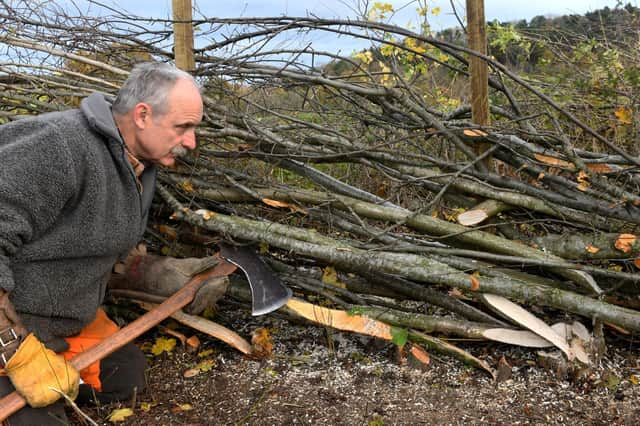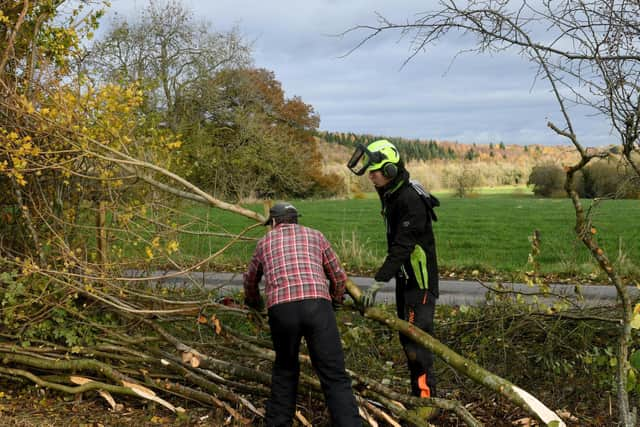Meet the Yorkshire champion hedgelayer with a passion for wildlife and an ancient skill


Jasper Prachek has been hedgelaying professionally for 35 years having originally started as a volunteer with the British Trust for Conservation when he was in his teens.
He is regarded as one of the county’s and the country’s best hedgelayers and has won the Yorkshire Hedgelaying title six times.
Advertisement
Hide AdAdvertisement
Hide AdJasper was judging at the 29th annual Yorkshire Hedgelaying Championships held at Galphay near Ripon last weekend and said that hedgerow management has a vital role to play in wildlife habitat, conservation and field management.


“I want hedges to work, to do their job and that job can vary dependent on what they are there for in the first place but largely hedgerows are used as a management tool.
“Their role on livestock farms is to manage stock, keeping it in or out, or as a border.
“When you trim the hedge for stock you want a lot of thorn in it, but then there are hedgerows that are just there to be aesthetically pleasing or as field boundaries.
Advertisement
Hide AdAdvertisement
Hide Ad“When it is laid, countryside stewardship schemes suggest you should put up a fence to protect the newly laid hedge.
“Either way all hedges need careful management. At the moment, I’m working on a hedge in Ardsley and I’ve cut it to withstand the stock getting through it. If they can’t get through, the hedge is doing its job.”
Jasper said the common mismanagement of hedges comes from those who see hedgerows as a problem rather than an asset or who just don’t understand how hedges work.
“I want the hedge to look good and to be able to rejuvenate itself. If it is left to simply grow it will get too big and all of the plants will get woody and it is then that it starts to die.
Advertisement
Hide AdAdvertisement
Hide Ad“Over time you lose the hedge completely if it is not managed properly.
“There are also those who just cut the hedge square, because it is easy and economical to do but in the long term that method of trimming will be the hedge’s demise.”
Jasper said the professional way to look after hedgerows and maintain them for future growth is to take appropriate action that will assist with growth and fill out the hedge.
“In order to hedge lay properly it is important to cut into a main stem at the ground with a saw or an axe which leaves you with a stock and the piece that comes over.
Advertisement
Hide AdAdvertisement
Hide Ad“The stock piece then produces new growth as well as the stem perpetuating the hedge if looked after correctly.
“By managing in this way the hedge will become thicker, it fills out and it is then able to keep stock out and provides a far better environment for wildlife to flourish.”
Jasper said the make-up of hedgerows varies around the UK.
“In Yorkshire most hedgerows are generally made up of thorn, but hedges differ around the country, in some parts there is more hazel used. The further north you go, generally the more thorn you find.
“There are around 17 styles of hedgelaying in the UK and then there are a number of variations of each. The Yorkshire style, that was used by those competing last weekend, is only a three-foot high hedge.
Advertisement
Hide AdAdvertisement
Hide Ad“It’s essentially a hurdle with a rail on top. You cut the stems to make the hurdle. It’s cut that way for strong regrowth. All of the stems have to sit on top of each other and you must not be able to get your hand through it. It’s a very neat hedge. The three-foot hedge is an arable style of hedgelaying.
“It’s a field divider and after several years it becomes lamb proof with appropriate trimming.”
When Jasper first started hedgelaying professionally his work was primarily taken up with council contracts. He said that those days are largely long gone and the impact of them not being tended properly is evident today.
“I worked on parkland, country parks and council estates but there is very little work on those now even though there is tonnes of work to do. They just haven’t the funds to give to it.
Advertisement
Hide AdAdvertisement
Hide Ad“My work is now far more on farms through environmental stewardship schemes.
“The schemes are gradually being changed which might increase all hedgelayers’ work further in future years.
Jasper said his passion for working outside had started at an early age.
“I was obsessed with natural history and still am. Anything to do with insects, fossils, wildlife and conservation. I learned to fish when I was four years old.
Advertisement
Hide AdAdvertisement
Hide Ad“I was already tree cutting in my teens and was used to using a hammer, bill hook or bow saw, which my dad bought me when I was 16 years old.
“I started working on people’s gardens to create some income when I was 14.
“I left school early to go on conservation courses and when I volunteered for the British Trust for Conservation Volunteers I would occasionally be given hedgelaying tasks.
“That’s where I started. When I passed my driving test I found that people would pay me for laying hedges and the rest was history.
Advertisement
Hide AdAdvertisement
Hide Ad“Being a hedgelayer is a vocation really. You don’t get paid loads of money and your season is only from September to March.”
Jasper said he is still as fascinated as ever by insects and wildlife.
“When a hedge has been laid about seven to eight years is when you get the maximum amount of insects. It varies wherever you go.
“At this time of year you have mature hedges with berries on and get fieldfares and redwings that are fed upon by the sparrowhawk. There’s that whole cycle going on. Lots of other things eat the berries too.
“It’s when you’ve got all that going on that you know you’ve got a real hedge.”